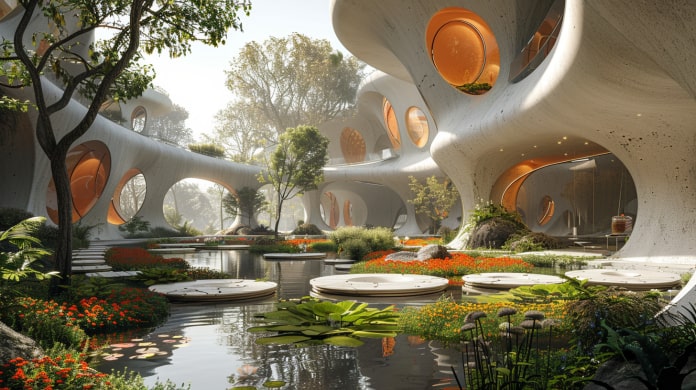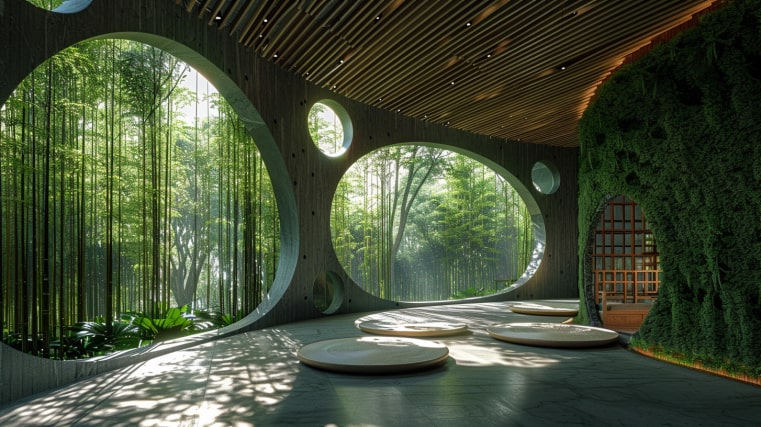Our minds are always working hard because modern life moves so quickly and is so full with technology. It’s not just a feeling of being busy; everything you see, hear, and process puts a measurable strain on your working memory.
Architecture is fighting back in 2025. Minimalist design is all the rage right now, but it’s not just a stylistic choice—it’s a smart way to improve your mental health. Minimalist Neuroaesthetics is a science-based method that uses minimal, harmonious design to literally soothe your nervous system.
Architecture in the future won’t be about how pretty a space looks; it’ll be about how calm it makes you feel. It’s about making things on purpose to give your brain a break.
What are Neuroaesthetics and Cognitive Load?
Neuroaesthetics is the study of how the brain reacts to art, beauty, and the things that people build. It connects neuroscience with design by employing tools like fMRI and biometric monitors to find out how people feel and think about settings.
The truth is that clutter is tiring. Your brain has to work a little harder every time it sees a loose wire, an extra ornamental item, or a complicated pattern. This is called cognitive load. This noise builds up over the course of a day, which can cause tension and mental exhaustion.
Minimalist architecture is the best way to fix this problem. Its main ideas—clean lines, clarity, and intention—make it easier for the brain to work. Instead of being a bunch of things that get in the way, the design becomes the space.

Source: reddymade.design
The Minimalist Advantage: Making Things Work for the Brain
A minimalist space uses two important neurobiological principles to lower cognitive load:
- Less visual noise: The brain uses less energy to process information when unnecessary things are removed, which frees up mental bandwidth.
- Harmonic Predictability: The brain can process simple, symmetrical, and balanced shapes more easily. Our minds want patterns that are rational, consistent, and predictable. This is what an architectural “grid” is all about.
This is how we came up with the concept of The Mindful Grid, where every design choice is made with the goal of improving the occupant’s mental health.
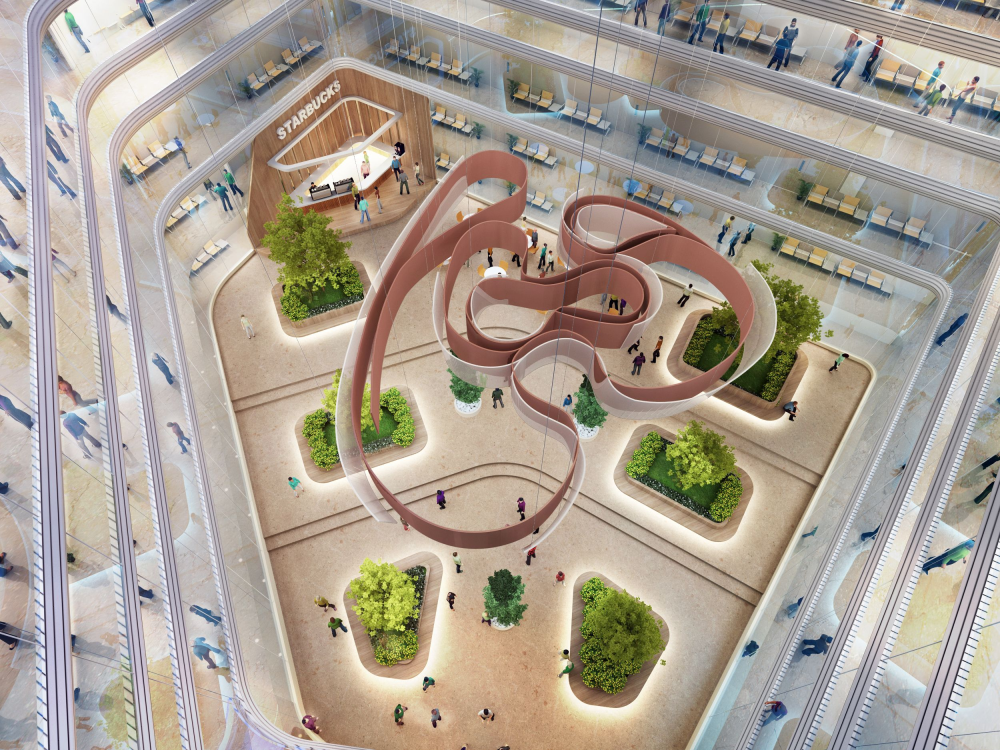
Source: commercialdesignindia.com
The Mindful Grid’s Four Pillars
Modern minimalist design is based on four main foundations that help people find true neuroaesthetic peace:
Negative Space as a Place to Rest
In minimalist design, the lack of an object is just as important as the object itself. This negative area isn’t empty; it’s a planned “visual pause.”
- Architectural Psychology: Walls that are open and not cluttered and floors that are big and open serve as a canvas for the eyes to land on without needing to be interpreted. This is an important part in lowering extrinsic cognitive load, which is the work that needs to be done to understand poorly designed or ambiguous material.
- The Power of Proportion: Minimalist architecture that works uses exact proportions, which are generally based on ratios like the Golden Mean. The brain releases hormones that make you feel good when an area feels geometrically balanced.

Honest Materials and A Calm Environment
The materials used in the Mindful Grid are chosen because they seem real and help the person feel grounded. The focus changes from smooth, fake finishes to rough, real surfaces.
The style for 2025 is moving away from cold, stark white boxes and toward Warm Minimalism. This includes rough-cut stone, textured concrete, and natural woods such light oak and cedar.
- Sensory Grounding: These materials appeal to our sense of touch. Touching a stone wall with texture or standing on a real wood floor is a simple and enjoyable approach to activate the brain that strengthens quality and stability, which lowers psychological tension even more.
- Sustainable Integration: This pillar fits in wonderfully with the Circular Economy movement. Materials are frequently low-VOC (volatile organic compounds) and come from nearby, which makes the air within healthier and makes the room more ethical.
Source: ugreen.io
Technology That isn’t Visible (lessening visual noise)
One of the biggest causes of visual clutter and cognitive overload is technology. In a neuroaesthetic minimalist home, technology has to blend in with the architecture.
Integrated Systems: The idea is to get rid of all the extra lines, screens, and control panels. This includes:
- Hidden Lighting: Recessed, layered, and indirect lighting that washes walls in warm tones, shaping the environment without the distraction of fixtures.
- Seamless HVAC: Linear slot diffusers and recessed baseboard vents that look like they are part of the wall or ceiling.
- Smart Automation: You may control the blinds, temperature, and audio using sensors that are almost undetectable or a single, simple, built-in panel. This gets rid of the “remote control cluster” problem.
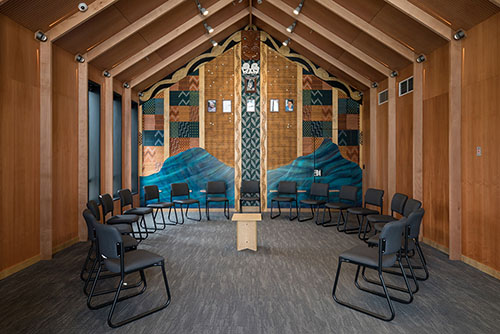 A therapy room at Tiaho Mai Acute Mental Health Unit, in Auckland, New Zealand, designed by Klein
A therapy room at Tiaho Mai Acute Mental Health Unit, in Auckland, New Zealand, designed by Klein
Biophilia and Fractal Patterns
Biophilic design, or our natural desire to interact with nature, is stronger in a minimalist setting. The outer world becomes the star when you take away the clutter inside.
- Nature as the Work of Art: The view becomes the major piece of art in the house thanks to large, continuous windows that frame a natural backdrop. This is a smart approach to take use of fractal patterns, which are the intricate, self-repeating shapes found in clouds, tree branches, and coastlines.
- The Stress-Reduction Effect: Research has demonstrated that exposure to these natural fractal patterns can diminish stress hormones and foster a sense of tranquility—a significant finding in neuroaesthetics. A sleek, minimalist frame keeps the inside from competing with this natural input that helps you feel better.
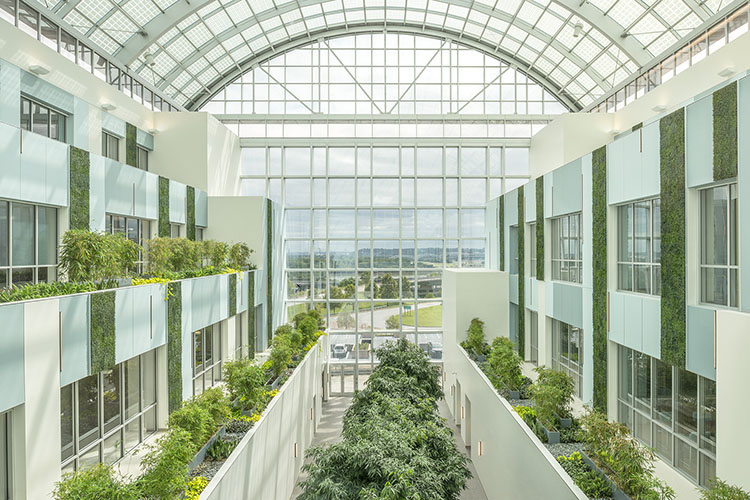 The atrium at the Strawberry Hill campus at University of Kansas, designed by CannonDesign.
The atrium at the Strawberry Hill campus at University of Kansas, designed by CannonDesign.
Designing for the Brain: Useful Tips
You don’t have to completely restructure the structure to use Minimalist Neuroaesthetics. Here are some things that architects and homeowners can do:
Choose built-in furniture over free-standing furniture wherever you can. For example, choose built-in storage, cabinets, and even chairs. This makes storage a part of the building, which cuts down on surface clutter by a lot.
- Curate with Purpose: Use the “less but better” rule on things. Keep only things that have a clear purpose or make you feel something real. You have to work for everything.
- Use Light to Define Space: Instead of walls, use changes in the hue, brightness, and direction of light to organically divide open-plan areas into zones for different functions. For example, use warmer light in the living room and brighter light in the kitchen.
FAQs: Neuroaesthetics in Minimalist Design
Q: Is Minimalist Neuroaesthetics only for fancy homes?
A: No. The basic ideas of eliminating clutter, using natural light, and simplifying color palettes are free, yet they do apply to premium design. Minimalism is a way of thinking about things that is not based on price.
Q: What is a good way to find out how much “cognitive load” my home has?
A: You can’t use a thermometer to measure it, but you can use your own observations. Think about how you feel in a room. The cognitive load is too high if you feel worried, restless, or distracted. A room with a “low load” helps you stay calm and focused.
Q: Does this style limit the usage of color?
A: Not completely, but color is used in a planned way. Minimalist Neuroaesthetics prefers broad areas of muted, earthy, or neutral colors (such greys, tans, and whites) as a quiet background. Then, color is added in small amounts, either as a small, meaningful accent or through natural elements like a living plant wall or a view outside.
For many this villa in the jungle is the epitome of a stress reducing environment – it is also very aesthetically pleasing. Source: imotions.com
The Quiet Revolution is the End.
Minimalist architecture is going through a discreet but big change in 2025. It’s not just a style choice anymore; it’s a promise to be healthy. The Mindful Grid turns a house into a high-performance machine for mental clarity by using the ideas of Neuroaesthetics. It is the highest form of function: a design made for the thought, not the eye.
As the world gets more complicated, the architectural sanctuary that intentionally lowers cognitive burden will become more than just a trend; it will be necessary.
Look for “Top Minimalist Architecture Trends 2025” to get additional high-end design concepts that use these ideas.
Reference
Neuroaesthetics: Designing Sustainable Environments for Society
The neuroaesthetics of architectural spaces
For more bogs like this CLICK HERE!!

